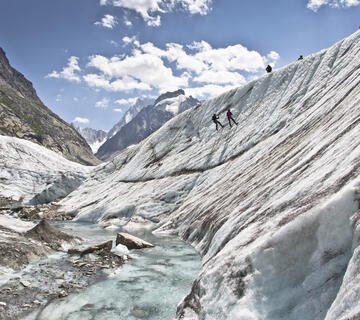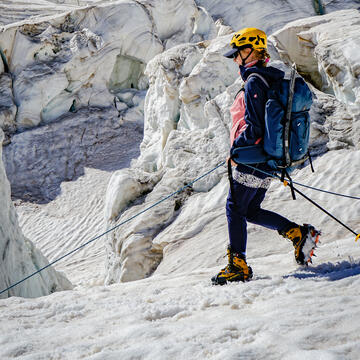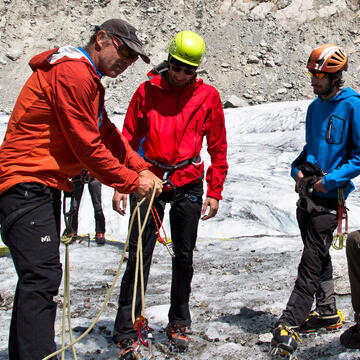At the tip of the spikes

Glacier walking is one of the Chamonix valley's most emblematic activities, and one that is attracting growing interest. Often perceived as a practice reserved for mountaineers, this activity is increasingly open to nature enthusiasts, curious to follow in the footsteps of the first summit explorers. But what is glacier trekking, and how do you prepare for it? Immerse yourself in an activity that combines discovery, technique and wonder.
A hike steeped in history

Crossing the Vallée Blanche on a glacier walk ©MR
The history of glacier walking in Chamonix is closely linked to the rise of mountaineering. At the end of the 18th century, figures such as Jacques Balmat and Michel Paccard marked the beginnings of glacier exploration by reaching the summit of Mont-Blanc in 1786. This expedition laid the foundations for a discipline that would transform the region's glaciers into grounds for adventure and scientific research.
With the arrival of professional guides in the 19th century, glacier walking gradually became more democratic. The Mer de Glace, one of the Chamonix valley's most emblematic glaciers, became a popular and accessible destination with the inauguration of the Montenvers cog railway in 1908. Since then, this activity has become an experience to be enjoyed, an invitation to reconnect with nature in an unfamiliar environment and with unfamiliar equipment.
Taking the first step
If the first steps are hesitant, they quickly become more fluid! With a little practice, you soon feel like an explorer. From then on, glacier travel is both a technical and fascinating discovery. Well-equipped, you move slowly, using simple gestures: walk slowly, feet slightly apart to avoid crossing the crampons, and keep your balance. You'll gradually gain confidence as you learn to adapt your pace to changing terrain and conditions.

Walking on a glacier is above all a sensory adventure. The fresh mountain air, the sound of crampons on ice and the snow-capped mountains offer total immersion in nature. But beyond these sensations, this activity offers numerous benefits.
The benefits of glacier walking

On a physical level, glacier walking puts the whole body to work. Climbs strengthen the legs, descents improve balance, and the altitude encourages deep breathing. It's an excellent cardio-respiratory exercise that improves endurance!
Mentally, the effect is just as powerful. Being up in the mountains in an almost monochrome landscape encourages reflection and disconnection. Participants often report a feeling of serenity, linked to both the physical effort and the wonder of the scenery. It's also an experience that boosts self-confidence, with each stage completed being a small victory ;-)
Nos conseils
Pour profiter pleinement de l’expérience, il est indispensable de bien se préparer. En premier lieu, s’entourer de professionnels expérimentés est essentiel. Les guides de Chamonix, formés aux spécificités des glaciers, assurent la sécurité tout en partageant leur passion et leur connaissance du milieu.
L’équipement joue un rôle clé. Si certains éléments peuvent être loués sur place, comme les crampons ou le harnais, prenez des vêtements adaptés aux conditions alpines : veste coupe-vent, sous-couches thermiques et gants isolants.
Enfin, la patience est une alliée précieuse. Marcher sur un glacier, c’est accepter un rythme lent. Vous verrez que très rapidement, ce temps au ralenti vous permettra d’économiser votre énergie et d'observer un panorama unique. Prendre le temps de vivre du temps perdu.

Les guides de montagne de la vallée
An environmental challenge: between wonder and responsibility
While the experience of glacier walking is unforgettable, it also brings with it an awareness of major environmental issues. Glaciers, silent witnesses to global warming, are receding at an alarming rate. In Chamonix, the Mer de Glace has lost dozens of metres of thickness in just a few decades. This phenomenon impacts not only the landscape, but also freshwater resources, alpine ecosystems and local populations. The practice itself, although accessible, requires particular vigilance. The balance between exploring this activity and preserving this fragile natural heritage is a central issue. So it' s crucial to follow the instructions of the professionals, stay on the marked routes and leave no trace of your passage. The Chamonix-Mont-Blanc valley, as a pioneering mountaineering region, plays an active role in raising awareness and promoting good environmental practices.
Numerous initiatives, such as educational programs for visitors and scientific collaborations, are aimed at raising awareness of the climate emergency. That's why the UN's " 2025, International Year of Glacier Preservation " has a special resonance in the Chamonix Valley. You can find out more about our awareness-raising activities here. By walking on a glacier, each participant becomes a witness to a changing world, and this experience can inspire a commitment to its preservation.









